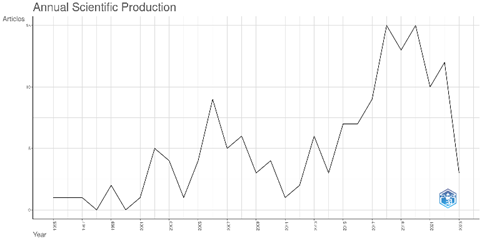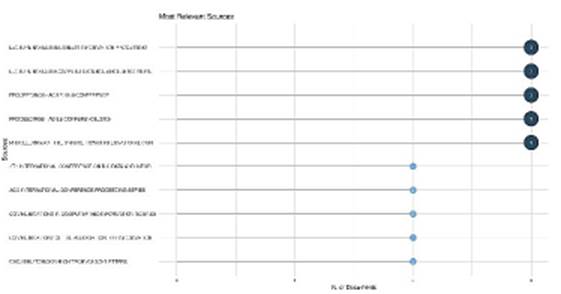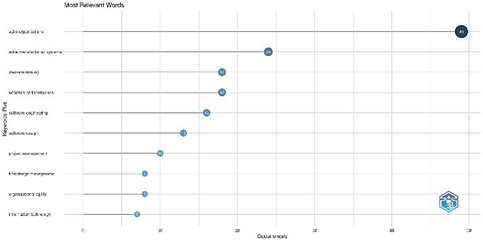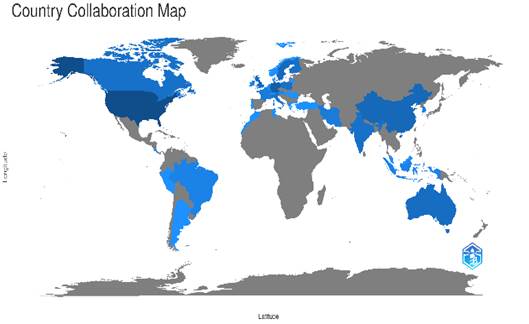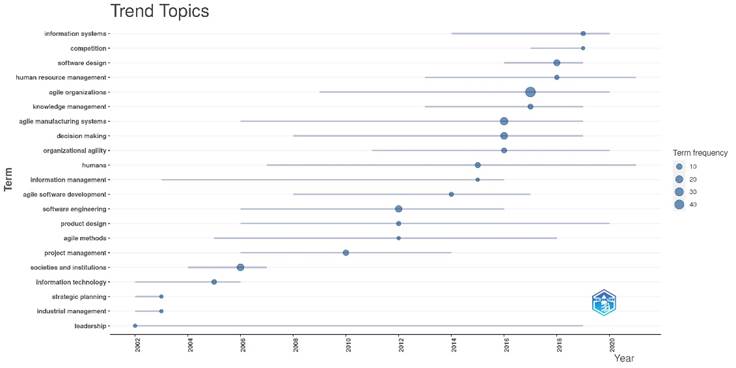1. Introduction
In the context of digitalization, agility and flexibility, structural changes in the way organizations proceed are taking shape [1]. Securing a robust competitive stance and attaining superior business performance poses a formidable task for companies, particularly amidst the uncertainties of a dynamic business landscape [2]. In that sense, the concept of Agile Organization acquires special relevance with respect to the new requirements when generating competitive advantages, innovation spaces and value co-creation. The changing environment is a source of threats and opportunities; however, agile companies extract maximum performance from emerging opportunities [3]. Consequently, for [4] the idea of an agile organization is a key element in management principles, intending to adapt production methods to an ever-evolving environment. According to [5], investigating agile transformation encompasses examining the context of a straightforward business model and a compact team, along with considering assumptions related to enhancing quality and reducing costs. For [6] agility is defined as a company's capacity to respond swiftly and adjust rapidly to new environmental conditions, addressing ongoing and unpredictable changes within competitive markets. Likewise, [7] define agility as the capability to sustain profitable operations in a competitive environment marked by continuously and unpredictably changing customer preferences. Thus, agile development teams acquire knowledge about customer priorities, while representatives from the customer side gain understanding regarding the feasibility and costs associated with implementing their requirements [8]. Consequently, changes in the organizational environment require agility to overcome new challenges amid technological transformations, competitive scenarios, and the increasing complexity of social systems as open systems in dynamic equilibrium. According to [9], the general characteristics of agility with the potential to be applied to all aspects of the company are the following: “flexibility, responsiveness, speed, change culture, integration and low complexity, mobilization of core competencies and high-quality customized products”. However, for [3] organizational agility is in a co-dependent relationship from the knowledge, freely usable information, experience, and creativity of its members. A specific challenge when implementing agile methodologies in larger-scale projects is the effective coordination between teams. Scaling agility to encompass broader initiatives introduces additional considerations and hurdles in coordinating with other organizational units, including Human Resources, Marketing, Sales, and Product Management [10]. In that vein, organizations in line with Agile Transformation require higher levels of innovation in a scalable way to achieve significant and functional changes towards dynamic states of adaptability amidst elements of unpredictability and uncertainty in their customer relationships and changes in the market, customer expectations and the environment. In this order of ideas, agile frameworks are increasingly incorporated for the transformation of organizations at all levels, to navigate through intricacy and unpredictability [11]. Hence, the adoption of agile software development approaches in extensive organizations is becoming more prevalent. Nonetheless, dealing with multiple teams and diverse products concurrently necessitates a heightened level of coordination and communication effort, diverging from the single-team environments for which agile methodologies were initially conceived [12].
This paper developed a descriptive bibliometric study of scientific research on agile organizations by analyzing the academic production based on bibliometric indicators. The research question was posed in the following terms: what are the main trends in the scientific production on agile organizations? Regarding the main results of the study, the volume of scientific production corresponds to 131 sources with the participation of 340 authors from various institutions and an annual growth rate of 4%. Regarding citation per article, the highest average of total citations per article is 85.2 with 5 articles in 2001 and the lowest is 0.08 with 12 articles in 2022. Finally, the keyword analysis has been developed in terms of co-occurrence, the most frequent descriptors are "agile organizations", "decision making", "organization and management" and "agile manufacturing systems". In terms of conclusions, agile methods imply a relevant lesson for organizational management, to think about organizational innovation and the proper management of teams or people in organizations.
2. Materials and methods
The present research is based on the Guidelines for Bibliometric Methods in Management and Organization [13] and the Integrated Methodology for Bibliometric Analysis [14]. In this sense, data obtained from the Scopus and Web of Science databases were integrated to perform the bibliometric analysis, in the search for an overview of the scientific production around agile organizations.
2.1. Data collection
Table 1 presents the search terms applied in Scopus and Web of Science to obtain the final data set for the analysis. The cutoff date for the search and data extraction was February 19, 2023. The R package used to integrate the Scopus and Web of Science data is called "tosr" [15]. Once the integration process has been carried out in R, duplicate documents are eliminated (30) and the final data set is obtained (150).
3. Results
The presentation of the results was performed by means of the R bibliometric research tool called Bibliometrix and the web application Biblioshiny [16]. The general information of the final dataset used for the bibliometric analysis is presented in Table 2. The papers were collected from 131 sources published between 1995 and 2023 (February 2023). The total number of authors is 340 and the annual growth rate 4% according to statistics provided by Biblioshiny. A total of 150 documents were used for the analysis.
Table 2 General information on the final data set.
| Description | Results |
|---|---|
| Main data information | |
| Time interval | 1995:2023 |
| Sources | 131 |
| Documents | 150 |
| Annual growth rate % | 4 |
| Average document age | 8,85 |
| Average citations per document | 12,35 |
| References | 5070 |
| Document content | |
| Keywords Plus (ID) | 694 |
| Author's keywords (DE) | 362 |
| Authors | |
| Authors | 340 |
| Authors of single-authored documents | 43 |
| Authors' collaboration | |
| Single author documents | 47 |
| Co-authors per document | 2,43 |
| International co-authorships % | 0,6667 |
Source: Own elaboration.
3.1. Scientific production
Fig. 1 presents the scientific production of documents by year. The volume of production is recorded in 131 sources with the participation of 340 authors from various institutions (170 affiliations). Regarding author collaboration, of the total of 150 papers, 47 are single-authored papers and international co-authorships are 0.6667%. Research on agile organizations at the general level is on the rise with a backward trend from 2006 to 2011, starting in the year 1995 with one paper and reaching its highest points in 2018 and 2020 with 15 papers each year. It should be noted that the year 2023 (January 2023) constitutes the data collection period and the number of articles is 3.
3.2. Citation
The average total citations per article, average total citations per year and citation years in relation to the annual production of articles are presented in Table 3. In that sense, the highest average of total citations per article is 85.2 with 5 papers in the year 2001 and the lowest is 0.08 with 12 papers in 2022; the highest average of total citations per year is 5.01 for the year 2007 and the lowest 0.02 for the year 2003 (excluding the data collection period).
Table 3 Average total citations per article and year.
| Year | Average total citations per article | N | Average total citations per year | Citable years |
|---|---|---|---|---|
| 1995 | 1 | 1 | 0,03 | 29 |
| 1996 | 2 | 1 | 0,07 | 28 |
| 1997 | 12 | 1 | 0,44 | 27 |
| 1999 | 12,5 | 2 | 0,50 | 25 |
| 2001 | 0 | 1 | 0,00 | 23 |
| 2002 | 44,6 | 5 | 2,03 | 22 |
| 2003 | 0,5 | 4 | 0,02 | 21 |
| 2004 | 20 | 1 | 1,00 | 20 |
| 2005 | 8,75 | 4 | 0,46 | 19 |
| 2006 | 6,33 | 9 | 0,35 | 18 |
| 2007 | 85,2 | 5 | 5,01 | 17 |
| 2008 | 14,17 | 6 | 0,89 | 16 |
| 2009 | 5,67 | 3 | 0,38 | 15 |
| 2010 | 3,5 | 4 | 0,25 | 14 |
| 2011 | 2 | 1 | 0,15 | 13 |
| 2012 | 2,5 | 2 | 0,21 | 12 |
| 2013 | 5,17 | 6 | 0,47 | 11 |
| 2014 | 23 | 3 | 2,30 | 10 |
| 2015 | 16,29 | 7 | 1,81 | 9 |
| 2016 | 5,71 | 7 | 0,71 | 8 |
| 2017 | 2,67 | 9 | 0,38 | 7 |
| 2018 | 6,8 | 15 | 1,13 | 6 |
| 2019 | 14,69 | 13 | 2,94 | 5 |
| 2020 | 19,47 | 15 | 4,87 | 4 |
| 2021 | 6,3 | 10 | 2,10 | 3 |
| 2022 | 0,08 | 12 | 0,04 | 2 |
| 2023 | 0 | 3 | 0,00 | 1 |
Source: Own elaboration.
3.3. Relevant sources
A total of 131 sources published research related to agile organizations from 1995 through February 2023. A source is a journal, conference, proceedings, or book published in one or more sources in the bibliographic collection [14]. Fig. 2 presents the top ten sources based on the number of papers published in each. The sources with the highest number of papers are as follows: Lecture Notes in Business Information Processing (LNBIP); Lecture Notes in Computer Science (LNCS) (including the subseries Lecture Notes in Artificial Intelligence and Lecture Notes in Bioinformatics); Proceedings - Agile Conference, 2008; Conference, Proceedings - Agile Conference, 2006 and Proceedings of the Annual Hawaii International Conference on System Sciences (HICSS) with 3 papers each.
3.4. Relevant sources
A total of 131 sources published research related to agile organizations from 1995 through February 2023. A source is a journal, conference, proceedings, or book published in one or more sources in the bibliographic collection [14]. Fig. 2 presents the top ten sources based on the number of papers published in each. The sources with the highest number of papers are as follows: Lecture Notes in Business Information Processing (LNBIP); Lecture Notes in Computer Science (LNCS) (including the subseries Lecture Notes in Artificial Intelligence and Lecture Notes in Bioinformatics); Proceedings - Agile Conference, 2008; Conference, Proceedings - Agile Conference, 2006 and Proceedings of the Annual Hawaii International Conference on System Sciences (HICSS) with 3 papers each.
3.5. Relevant and influential authors
Fractional authorship quantifies the contributions of an author to a set of published articles, based on the assumption that all co-authors contributed to each paper equally [14]. Table 4 presents the ten most relevant and influential authors in relation to agile organizations based on the number of articles and fractional articles. The first three positions are occupied by the authors: Li, X., Baker, S. and Barbalho, S.
3.6. Relevant affiliations
In terms of author affiliations for correspondence (APC), the total corresponds to 170. The following are the most relevant in terms of number of articles: Slamic Azad University (3), Applied Science University (2), Bina Nusantara University (2), Carnegie Mellon University (2), Center hospitalier de l'Université de Montréal (2) as presented in Fig. 3.
3.7. Factor analysis
Factor analysis based on Multiple Correspondence Analysis (MCA) is represented in Fig. 4. Each color incorporates a group of words for a specific topic or subfield. The factorial analysis identified two dominant macro groupings regarding the research topic. The first group (blue) is made up of the human factor, organizational innovation, and organization and management. The second group (red), the most dominant, brings together agile methods, agile transformations, agile software development, and agile organizations, among others.
3.8. Relevant keywords
The ten main keywords used in the documents included in the final data set used for the bibliometric analysis are presented in Fig. 5. In addition to the base term of the research, “agile organizations”, other relevant terms identified are the following: "agile manufacturing systems", "decision making", "societies and institutions" "software engineering", "software design" "project management" and "knowledge management" with an occurrence of 24, 18, 18, 16, 13, 10 and 8, respectively.
3.9. Scientific production by country
Fig. 6 presents the countries that produced the largest number of articles: United States (33), Germany (14), China (8), Australia (7), Sweden (7), United Kingdom (7), Poland (6), Canada (5), Finland (5), India (5), France (3), Iran (3), Austria (2), Bahrain (2), Brazil (2), Denmark (2), Indonesia (2), Ireland (2), South Korea (2) and Argentina (1).
3.10. Trend topics
For trending topics, the keyword frequency criterion by year was used. The bibliometric analysis revealed trends of research related to agile organizations in recent studies and are presented in Fig. 7: Agile Manufacturing Systems (24: 2016), Partnerships and Institutions (18: 2006), Decision Making (18: 2016), Software Engineering (16: 2012), Software Design (13: 2018), Project Management (10: 2010), Organizational Agility (8, 2016), and Knowledge Management (8, 2017).
3.11. Co-occurrence network
Finally, the keyword analysis has been developed in terms of co-occurrence using the software tool for building and visualizing bibliometric networks VOSviewer. Fig. 8 presents the visualization of the keyword co-occurrence network. The highest frequency descriptor is "agile organizations" with an intermediate of 602.51 followed by "decision making", "organization and management" and "agile manufacturing systems" with intermediate of 213.75, 156.00 and 128.12, respectively.
Cluster 1 (blue) is focused on agile organizations around topics such as Software Engineering and Design, Project Management, Agile Methods, and Human Resources. Cluster 2 (green) relates the topics of Agile Manufacturing Systems, Decision Making, Product Design, Industrial Management, Strategic Planning, and Industrial Management. Finally, cluster 3 (red) focuses on Organizational Agility exploring topics related to Organizational Structure, Knowledge Management, Strategy, Competence and Organizational Change Management.
4. Discussion and conclusion
Agile organizations arise as a demand from the environment in which structural changes are made [1] to achieve dominant competitive positions [2], this concept somehow replaces that of Market Orientation that was coined in the 90s and that, although in its beginnings it raised an internal and external view of the organization, it has focused on three approaches: product innovation, organization performance and customer orientation. internal market [17].
In this sense, the concept of Agile Organizations leads to Agile Transformation in which relevance is given to quality improvements, cost reduction, operating profitably, as well as the ability to suddenly adapt to a changing environment [6-8]. Consequently, the agility of an organization places value on having managers who allow their teams to develop with flexibility to make the most of their creativity. Likewise, other results show three clusters that combine, first, human resources and project management, second, manufacturing and design with decision making, and third, structure, strategy, change and knowledge management. This allows us to analyze the relevance of organizational management and all its fields of action in the field of thinking about an agile organization.
Finally, the results of this study allowed the identification of two dominant trends with respect to the research topic. The first involves issues such as the human factor, organizational innovation and organization and management, which represents a trend in terms of organizational structuring from the individual in their relationships in an organizational context in the pursuit of agility. The second groups agile methods, agile transformations, agile software development and agile organizations, among others, which implies the consolidation and results of the application of agile frameworks across different levels of organizations. Consequently, it is evident that the agile methods that started in Software Engineering as a response to achieve projects that respond quickly to the needs of users, left a relevant lesson for Organizational Management, to think about organizational innovation and the proper management of teams or people in organizations.
4.1. Future research challenges and opportunities
Therefore, future research should explore ways to operationalize and measure organizational agility and concepts such as: Agile enterprise, Agile Work Culture, Agile Manufacturing, Agile Methods, Agility Capability, Agility Facilitators, Agility Enablers, Organizational Agility, Human Resource Agility, Co-evolution, Edge of chaos and Self-organization to continue with the study of concepts from the organizational level towards complexity in the midst of open social systems that imply increasing challenges in terms of adaptability.
5. Glossary
Agile enterprise. An agile enterprise is an organization that employs fundamental principles from complex adaptive systems and complexity sciences as a foundation for achieving success [4]. Agile companies respond promptly and efficiently to shifting markets, propelled by tailored products and services [18].
Agile Manifesto. In 2001, a collective of software developers, recognizing the imperative for change, released the Agile Manifesto, giving rise to the "Agile" methodology aimed at adapting to diverse requirements [19]. The manifesto represents the basis for most agile methods and practices today [20].
Agile methods. A distinct set of methodologies, referred to as agile methods, is employed to tackle diverse challenges arising from evolving requirements, unpredictable outcomes stemming from technological intricacies, and the dynamic nature of systems, including uncertainty induced by overall system complexity [4].
Agile organizations. Organizations that swiftly acquire knowledge by integrating their agility capabilities with the functions of the organization, adjust promptly to the environment, anticipate change, cultivate a culture aligned with this approach, and embrace agile methodologies [19].
Agile work culture. An agile work culture involves promptly adapting to environmental changes rather than adhering strictly to a predefined process. The term originated in the context of software development, allowing programmers the flexibility to develop the product continuously and fluidly [21].
Agile. The agile paradigm advocates for conducting the software development activities of a project in an iterative and incremental life cycle, aiming to generate value at the conclusion of each cycle. It emphasizes active involvement of stakeholders and end users in these cycles [19].
Agility. Agility surfaced nearly three decades ago in response to dynamic economic landscapes and increased global competition [19]. Agility is the quality of an organization that empowers adjustments in the execution scope of operations, processes, and business relationships in reaction to evolving external and internal circumstances [4].
Co-evolution. Co-evolution serves as a critical process through which a company assimilates knowledge from experience and adjusts; the agile company consistently transforms in alignment with, and in response to, external factors in the environment [4].
Edge of chaos. The edge of chaos is a transitional zone positioned between anarchy or complete randomness and a state of equilibrium; the agile enterprise ideally functions within this realm, requiring a delicate balance between continual change and constraints that may impede the organization's transformative endeavors [4].
Self-organization. Self-organization refers to the spontaneous, unplanned, and feedback-driven interactions that occur within agile enterprises [4].














